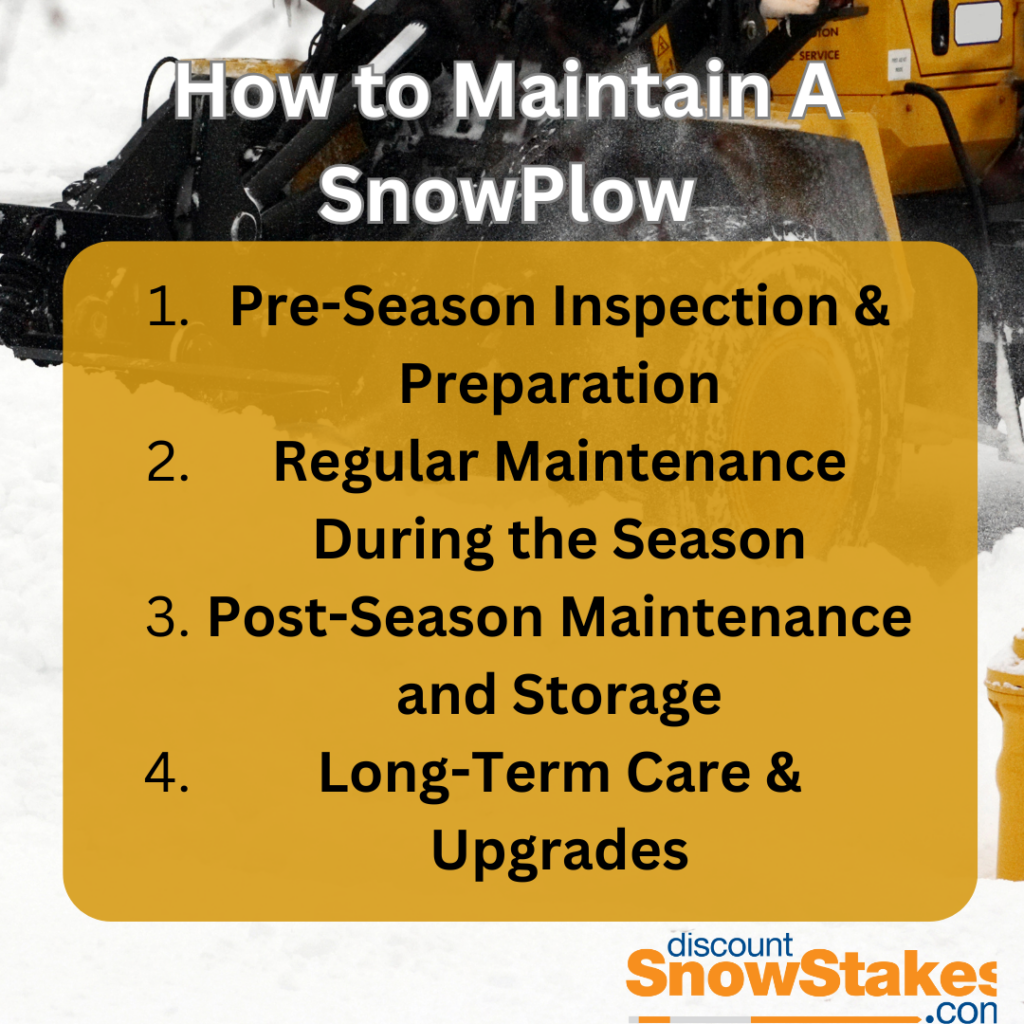It’s hot now, but its never too early to think about winter. When winter comes, snowplows become essential in keeping roads clear and safe. For those who own and operate snowplows, proper maintenance is critical to ensure they function efficiently throughout the snow season. Neglecting maintenance can lead to costly repairs, downtime, and safety hazards. Here’s a comprehensive guide on how to maintain a snowplow, keeping it in top condition for the winter months.
1. Pre-Season Inspection and Preparation
Before the first snowflake falls, it’s crucial to conduct a thorough inspection and preparation of your snowplow. Here’s what to focus on:
a. Inspect the Plow Blade:
- Check for Damage: Look for any cracks, bends, or significant wear on the blade. Minor damage can often be repaired, but severe damage might require replacement.
- Edge Condition: Examine the cutting edge for wear. If it’s significantly worn down, replace it to ensure efficient snow removal.
b. Hydraulic System:
- Fluid Levels: Check hydraulic fluid levels and top them off if necessary. Use the manufacturer-recommended hydraulic fluid.
- Hoses and Fittings: Inspect for leaks, cracks, or wear. Replace any damaged hoses or fittings to prevent hydraulic failure during operation.
c. Electrical System:
- Connections and Wiring: Check all electrical connections and wiring for corrosion or wear. Clean or replace corroded connectors and ensure all wiring is secure.
- Lights and Reflectors: Test all lights and reflectors to ensure they are functioning correctly. Replace any burnt-out bulbs or damaged reflectors.
2. Regular Maintenance During the Season
Once the plowing season is underway, regular maintenance is essential to keep your snowplow operating smoothly. Here’s what to focus on during the season:
a. Blade and Cutting Edge:
- Daily Inspection: After each use, inspect the blade and cutting edge for any damage or excessive wear. Promptly repair or replace damaged parts.
- Lubrication: Lubricate all pivot points and hinges regularly to ensure smooth operation.
b. Hydraulic System:
- Fluid Check: Check hydraulic fluid levels frequently, especially after extensive use. Look for any signs of leaks and address them immediately.
- System Performance: If the hydraulic system seems sluggish or unresponsive, it may indicate low fluid levels or other issues. Investigate and resolve these problems promptly.
c. Electrical Components:
- Battery Check: Ensure the vehicle’s battery is in good condition and fully charged. Cold weather can be hard on batteries, so consider a battery heater if operating in extremely cold conditions.
- Connector Cleaning: Regularly clean electrical connectors to prevent corrosion and ensure reliable connections.

3. Post-Season Maintenance and Storage
At the end of the plowing season, proper maintenance and storage are crucial for preserving the longevity of your snowplow. Here’s what to do:
a. Thorough Cleaning:
- Remove Debris: Clean the plow thoroughly, removing any snow, ice, salt, and debris. Pay special attention to the underside and any hard-to-reach areas.
- Wash and Dry: Wash the plow with soap and water, then dry it completely to prevent rust and corrosion.
b. Inspect and Repair:
- Detailed Inspection: Conduct a detailed inspection of all components, including the blade, hydraulic system, and electrical parts. Identify any damage or wear and make necessary repairs.
- Touch-Up Paint: Touch up any chipped or scratched paint to prevent rust.
c. Storage Preparation:
- Fluid Levels: Top off all fluids, including hydraulic fluid and any other lubricants.
- Protective Covering: Apply a protective coating or cover to the plow to shield it from dust, moisture, and other environmental factors during storage.
- Proper Storage: Store the snowplow in a dry, sheltered area, preferably indoors. If indoor storage is not available, use a heavy-duty cover to protect it from the elements.
4. Long-Term Care and Upgrades
To ensure your snowplow remains in top condition for years to come, consider these long-term care and upgrade tips:
a. Regular Training:
- Operator Training: Ensure all operators are trained in proper usage and maintenance of the snowplow. Proper operation reduces wear and tear and minimizes the risk of damage.
b. Scheduled Servicing:
- Professional Servicing: Schedule regular professional servicing to keep your snowplow in optimal condition. Professional technicians can identify and address issues that might not be apparent during routine inspections.
c. Upgrades:
- Technology Upgrades: Consider upgrading to newer technology, such as GPS tracking, advanced hydraulic systems, and improved blade designs. These upgrades can enhance efficiency and performance.
Maintaining a snowplow requires diligence, regular inspections, and timely repairs. By following these maintenance tips, you can ensure your snowplow remains reliable and efficient throughout the winter season, keeping roads clear and safe. Proper pre-season preparation, in-season care, and post-season maintenance are key to the longevity and performance of your snowplow, making it a dependable ally against the harshest winter conditions.

